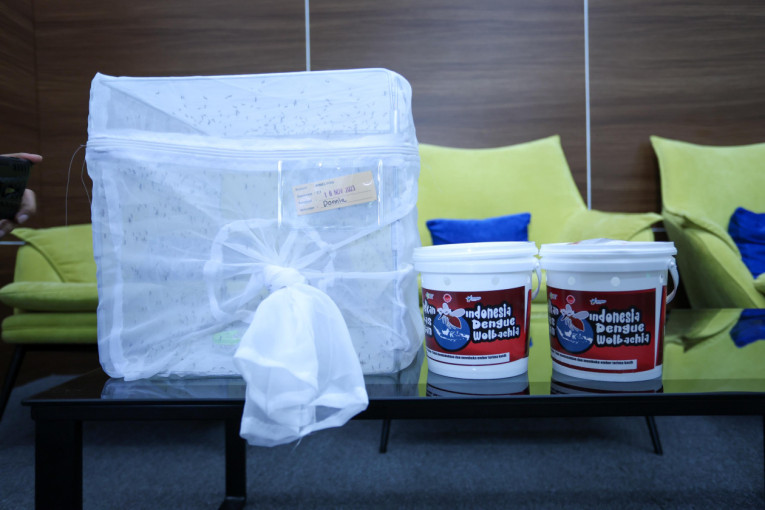Yogyakarta has become the first city in Indonesia to implement Wolbachia-infected mosquito technology to control dengue fever (DF).
Since the inception of this program in 2016, the number of DF cases in Yogyakarta has gradually decreased, reaching its lowest point in 2023 at 67 cases.
“In 2016, the number of cases in Yogyakarta was still very high, reaching more than 1,700 cases. In 2023, until last week, only 67 cases were recorded, the lowest in the history of Yogyakarta,” said Lana Unwanah, MD, Head of Disease Prevention and Control at the Yogyakarta Health Office, on Wednesday (November 22).
“In addition to the known methods such as mosquito eradication with 3M and larval surveillance, the decline in cases is also attributed to the intervention of the Wolbachia-infected mosquito program carried out since 2016 until now.”
Research related to Wolbachia-infected mosquito technology in Indonesia was conducted by the World Mosquito Program (WMP) Yogyakarta, a collaboration between the UGM Faculty of Medicine, Public Health, and Nursing, Monash University, and the Tahija Foundation.
This advanced technology was implemented in Yogyakarta by depositing buckets containing Wolbachia-infected Aedes aegypti mosquito eggs in their natural habitats in the community, with the support of the Health Office and various stakeholders.
Thanks to this program, the control is now more effective. Along with the decreasing case numbers and hospitalization rates, the need for physical interventions such as fogging has decreased.
The local government budget for DF handling has become more efficient and can be allocated to treating other diseases.
“We express our gratitude to Professor Uut (Adi Utarini) and the team who conducted research and implemented the Wolbachia-infected mosquito program, making Yogyakarta the location of the pilot project,” Unwanah said.
Appreciation for this program also comes from community figures. Totok Pratopo from Cokrodiningratan Village expressed his appreciation.
Before the implementation of the WMP program, the spread of DF in the village was quite concerning. New cases always emerged towards the end of the year, leading to deaths.
“The villages on the banks of the Code River have high potential because the level of cleanliness is lower, and there are many puddles. Fortunately, this technology was found,” Pratopo expressed.
“Today, my village, Jetisharjo, has zero cases. No one has been admitted to the hospital and died. This is truly relieving for us, the community.”
According to him, this technology is complex for the layman to understand. This might have caused some people to doubt the effectiveness of the program.
“So far, we have been taught to eradicate mosquitoes, and now we want to spread mosquitoes,” he added.
Approaching a Decade of Contribution to Indonesia’s Health
Significant milestones have been recorded throughout the research journey and the implementation of Wolbachia-infected mosquitoes.
After going through a series of processes, the first release of Wolbachia-infected Aedes aegypti mosquito eggs was carried out in 2014 in four small hamlets in Sleman Regency and Bantul Regency.
Thus, for almost ten years, some of the people of Yogyakarta have lived with Wolbachia-infected mosquitoes.
The Chief Researcher of WMP Yogyakarta, Professor Adi Utarini, explained that this technology was preceded by a risk analysis by an expert team formed by the Directorate General of Research, Technology, and Higher Education to identify potential impacts. The conclusion was that the risk of applying this technology was very low or negligible.
“It was not applied immediately; there was an important process beforehand. Everything was done with caution and accompanied by ethical clearance,” Professor Utarini explained.
The WMP in Yogyakarta ended in 2022, with results proving that this technology effectively reduced DF cases by 77% and hospitalizations by 86%.
With this data, WMP then obtained recommendations from the World Health Organization (WHO) and the Indonesian Academy of Sciences (AIPI) to implement this technology in other cities in Indonesia.
The WMP team has developed an implementation model in collaboration with regional Health Offices, including conducting training activities and providing a guidebook.
Sustainable Protection
After the program’s end, monitoring the number of cases and mosquito observations continues to be carried out by the Center for Tropical Medicine Center at the UGM Faculty of Medicine, Public Health, and Nursing.
The center’s director, Dr. Riris Andono Ahmad, MD, also one of the WMP researchers, explained that Wolbachia-infected mosquito technology is sustainable, environmentally friendly, and safe for health.
“This technology is sustainable because its nature can be passed on to the next generation of mosquitoes. It only needs to be released once, and then we enjoy the results. The Wolbachia population in Yogyakarta is still very high, providing sustainable protection,” Dr. Ahmad said.
Author: Gloria
Photographer: Donnie






